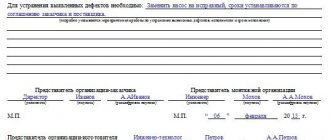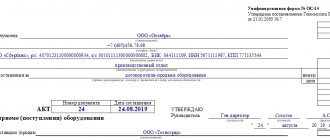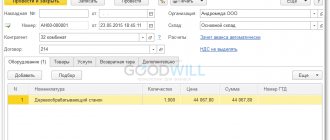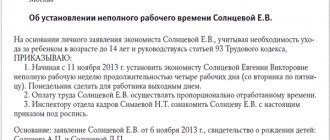If the enterprise receives new equipment, regardless of whether it was purchased or received as a gift, a commissioning certificate is drawn up for it based on the rules for maintaining accounting documentation. The commissioning certificate is a document certifying that the received or purchased product is free of defects and meets all stated requirements and safety standards. Equipment received for production from the supplier is tested for integrity and inspected by a commission for malfunctions. Moreover, if an object requires maintenance, then the document is drawn up after preparatory work has been carried out, when the equipment is ready for use. If the equipment has arrived at the enterprise and is ready for operation, then the report is drawn up immediately.
Checking equipment received for production
Objects
Since each object has its own specifics, the content of the act can be different and drawn up in free form. But this does not mean that drafting a document does not require increased attention. Rather, on the contrary, this matter must be approached with full responsibility, since the health and life of enterprise employees depends on various types of technical equipment. Main types of objects:
- tools, as well as household and productive equipment;
- equipment for various purposes;
- real estate, land, buildings, roads;
- transport with special equipment;
- equipment and computing machines;
- objects of flora and fauna used for commercial purposes.
Requirements for filling
Filling out the act of putting equipment into operation does not have clearly defined requirements - each enterprise or organization that is one of the parties to the purchase and sale agreement has the right to follow its own procedure.
In practice, filling out the act and the procedures preceding it have such features.
The commissioning certificate can be signed both directly by the parties to the transaction - the buyer and seller, and by specially authorized persons. In practice, in large enterprises, persons whose job responsibilities are related to registering machines (chief accountant), bearing financial responsibility for it (head of a workshop or production), as well as direct use (foreman, line operator, etc.) are allowed to sign the act. .).
In the process of drawing up the act, the following characteristics are checked:
- serviceability of equipment - through external inspection and commissioning;
- conditions for its placement - compliance with technical requirements, compliance with the distance to walls or structural elements of the room and the size of passages between devices and lines;
- correct connection to networks and communications;
- the absence of any factors that may pose a danger to employees performing work operations on it;
- absence of defects in semi-finished products and products produced by the equipment;
- compliance with sanitation and labor protection standards, fire safety, etc.
If during the inspection any violations of the established parameters or malfunctions are discovered, then an entry must be made in the report. Detection of such problems must be accompanied by their elimination. Otherwise, the client (buying company) has the right to refuse to complete the transaction, and, accordingly, to refuse to pay for it.
In the event that during the initial inspection, problems or defects were noticed, which were later eliminated, then after they have been eliminated, a second inspection is carried out as part of the commission.
It is important to note the need for a clear distinction between material assets, the acceptance of which from suppliers and registration is not accompanied by the execution of a commissioning certificate - such an action is not applied to stationary objects (process tables without conveyors, pieces of furniture), as well as to office equipment (computers, printers, scanners, etc.).
The feasibility of drawing up a commissioning certificate
After the inspection has passed, is successful and the document has been signed, the equipment is placed on the balance sheet, that is, depreciation payments begin to be accrued on it, and this affects the increase in the company’s costs. The act of putting fixed assets into operation and a sample of its completion can be seen below. Such a document is compiled for several reasons:
- Some suppliers find it important to unpack and inspect their goods. This is necessary in order to start the warranty period according to all requirements;
- signing the act confirms the safety and performance of the product. The commission evaluates the condition of the object, compares its real and declared characteristics, and then establishes the appropriate safety requirements for operation;
- For companies, consumers set their own conditions at the time of purchase. First, they check the integrity of the purchase and only then transfer the remaining payment to the supplier for the goods.
Certificate of commissioning of fixed assets sample
The act is drawn up not only when the purchased equipment is released into production, but also in the case of modernization or repair of an object that came from another place of use.
Before forming the act
If special equipment requires inspections and tests, these procedures must be completed before issuing a report.
Basically, special equipment is checked for defects, malfunctions and defects, as well as whether it meets the required norms and standards. This is done by a specially formed commission.
- Receive the commission’s conclusion on the serviceability of special equipment;
- Create a technical act (it will protect the organization in case of an emergency);
- Receive a delivery certificate to the company;
- Draw up an act for the repair or reconstruction of special equipment.
Only after all these actions can you create a certificate of commissioning of fixed assets and begin to use the facility.
Procedure for commissioning equipment
The procedure for transferring an object into operation depends solely on its type. There is no need to put simple objects into operation, such as furniture, office equipment, etc. All that is required is to issue a transfer document. This can be certified by the head of the department, the chief accountant, the supply manager or the worker receiving the property. In addition, if new equipment is purchased, then you don’t have to record this in terms of fixed assets, and it’s enough to limit yourself to a transfer and acceptance certificate with a specified start date for using the equipment. However, if over time the equipment requires servicing, then drawing up a report is mandatory, especially if the equipment is complex in design. The commission checks in the following order:
- Inspection.
- Condition assessment.
- Installation check.
- Trial run.
- security check.
- Familiarization with permitting documentation.
- Assigning appropriate conditions for using the object.
The document is drawn up by a commission including representatives of both parties, as well as interested parties from third-party companies. When the act is successfully signed, it is sent to the accounting department for subsequent approval by the manager and chief accountant. If during the inspection discrepancies with legal requirements were found, then a corresponding entry is written in the text of the document. When problems are identified during the inspection, the equipment is sent for repair, and after the breakdowns are corrected, it is checked again and a new equipment commissioning report is drawn up, a sample of which is presented below. When the secondary check is successful, a mark is placed inside the document allowing the use of the mechanism in production.
Certificate of acceptance of equipment into operation sample
Definition and necessity
The act of putting equipment into operation is an official document confirming the fact that machines and devices comply with the declared (certificate) characteristics and their implementation at the enterprise, i.e.
carrying out a test run. The current legislation of the Russian Federation does not oblige legal entities and individuals to draw up such an act. However, in practice, it is drawn up and signed in most cases and is used in order to avoid any problems associated with a malfunction or lack of functions that should be inherent in it during further use. This action is necessary for both parties to the business or commercial relationship:
- For an organization that has sold machines or devices, such a document confirms that they are in good working order and in the event of any malfunctions, it will not bear any responsibility (with the exception of special cases of defects in individual parts, when such a fact cannot be determined during inspection and startup). Maybe).
- For a company that purchases equipment. In the absence of such an act, devices and machines that were initially faulty or had any defects can be accepted for balance. If any breakdowns are further identified, it will be very difficult to make a claim to the seller and prove that the breakdown was present before it was put into operation. Such cases, of course, exist in judicial practice, but wasting time and expenses on litigation is not beneficial for either the buyer or the equipment supplier.
In addition to excluding mutual claims between the supplier and the buyer, the act of putting equipment into operation is also necessary from the point of view of its safety - in this way the client can ensure that all necessary labor safety requirements can be met.
This issue is very important for production, since harm to the health of workers or their death that occurs at work entails a lot of unpleasant moments, which may even result in criminal prosecution of those responsible for safety at the enterprise.
In the event that a ready-made piece of equipment is delivered to the company, the operation of which only requires a connection to the network (if, of course, electricity is necessary for operation), then the commissioning report is drawn up immediately. Then members of the commission are invited in advance, and a standard form of the document is drawn up, which, in the absence of problems and any mutual claims, is signed.
Often, the supplied equipment requires additional assembly, installation and connection to several networks (water supply, electricity, gas sewerage) for trial commissioning. In such situations, the equipment supplier delivers machines and devices, installs them, and only after all the preparatory work is completed, then the devices are inspected and launched.
In order to avoid any claims to the equipment, from the moment of delivery until its complete installation, employees of the company purchasing it are not allowed (this means carrying out any work).
Basically, purchasing companies make payments for the purchase of lines, machines and devices only after installation and a trial run - this is their main condition for carrying out the transaction.
If a commissioning certificate is issued for new equipment (machines, lines, devices), such an operation confirms its compliance with all the initial parameters or characteristics that the tested object must have according to the passport and technical standards.
In the event that a specific facility is commissioned after repairs or its partial or complete reconstruction, then the requirements for equipment may already be slightly changed and reflected in the service agreement.
Basic rules for drawing up a commissioning act
The legislation does not propose a unified and mandatory form. Accordingly, the parties draw up the act in any form, adding there what they consider necessary, or are guided by the already existing internal template of the enterprise. The act is drawn up either on an A4 sheet or on the company’s letterhead. We show the general act of acceptance of equipment into operation, a sample of which is also presented in the picture. The document may contain the following information:
- equipment inspection date;
- place and address where inspection and installation took place;
- name of the equipment manufacturer;
- full name, technical characteristics of the equipment;
- description of the conditions for using the equipment;
- additional data, comments;
- results of testing and commissioning;
- who was on the commission.
The equipment commissioning certificate form must be written in three copies, and technical documentation must be attached to them, such as a passport, operating rules and other accompanying documents. The act must be approved by the leaders on both sides and all members of the commission.
Instructions for writing a water act for operation
- In the first part of the document, its name is written, and its essence is also briefly indicated (in this case, “about the commissioning of equipment”). The line below indicates the locality in which the act is created and the date: day, month (in words), year. Then the composition of the commission that checked the equipment is entered: the positions of the employees are entered, as well as their last names, first names, and patronymics. Here you should also make a reference to the order of the director who appointed the commission (indicate the full name of the enterprise, surname, first name, patronymic, manager, number and date of the order).
- The main part is to certify the fact that the equipment has been examined and inspected by the commission. Here you need to enter its name, serial number, technical characteristics, name of the manufacturer, place of manufacture of the equipment, etc. options. The regulations, laws, documents on the basis of which the inspection was carried out and its timing are also recorded here.
- The third part of the document contains information about the condition and quality of the equipment being put into operation. If it is in good condition, then this should be noted; if it has any defects or malfunctions, then this should also be indicated. If there are any comments, they must be included in the act with all the details. Next, you should add a clause about the commissioning work carried out, as well as that the equipment meets all safety requirements (fire, technical, environmental, industrial).










